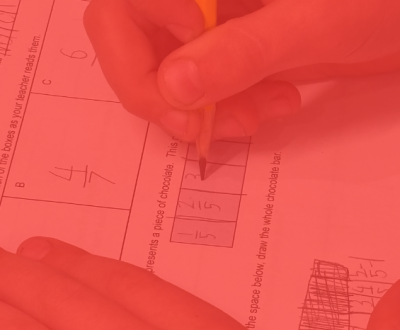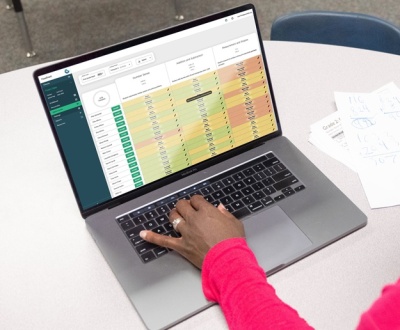The Case for Instructionally Useful Assessments
- January 17, 2025
- Blog

In the Information Age, we’re overwhelmed with information. For educators, this reality is especially pressing. The data about our students is endless, pulled from high-stakes tests, classroom assessments, formative tools, gamified platforms, and a growing array of skills-based technologies.
Much like society’s struggle to sift through mountains of information, educators face the monumental task of sorting through siloed, disconnected data about their students. The noise makes it hard to see what’s most important, what to focus on, and what will genuinely help students move forward. The result? Data paralysis—an overwhelming sense of having too much information but too little clarity about how to use it.
In a previous article, we explored slow assessment—prioritizing quality over quantity, and dedicating time to the assessment process. But the very idea of “quality information” is elusive in education. What are the assessments that truly matter for teachers? Which ones help educators identify areas for targeted instruction? How can we ensure the time spent assessing students actually serves them? In this article, we focus on instructionally useful assessments—those that drive meaningful teaching and learning—and why educators should prioritize investing their time, energy, and resources in tools that make the biggest impact on student success.
Assessments Used for Teaching and Learning Should Be Formative
If we want to improve student learning, we must challenge our reliance on assessments that merely confirm what we already know. Many high-stakes assessments fall into this category. While benchmarking and interim tools often serve an important purpose in resource allocation and program evaluation, they rarely improve what happens in the classroom. They’re snapshots—static records of what students know or don’t know at a given moment, and too broad in scope to provide diagnostic information.
But assessments used for informing instruction shouldn’t be big picture snapshots. They should be to-do lists—dynamic tools that guide educators on where students need improvement and what steps to take next. In other words, they should be instructionally useful.
The idea of formative assessment aligns closely with this approach. According to the Eberly Center at Carnegie Mellon University, “The goal of formative assessment is to monitor student learning to provide ongoing feedback that can be used by instructors to improve their teaching.” Feedback is at the heart of this process, but it must go beyond surface-level insights. It needs to be specific, actionable, and tied to what happens in the classroom.
Formative assessments help educators teach more effectively by offering real-time insights into student understanding. For an assessment to be truly formative, it must meet a few critical criteria:
-
- Timeliness: Feedback must arrive quickly enough to influence current instruction. If it’s delayed, the moment to act has already passed.
- Actionability: Feedback must be clear and specific about what to do next. Vague or overly technical data isn’t helpful. Results that lack context or don’t align with the instructional program are essentially useless.
- Alignment: The assessment should connect directly to the skills or standards being taught in the classroom or provide insights for future planning. Misaligned assessments distract from the core goals of instruction.
Expanding the Concept: Instructionally Useful Assessments
When we think of formative assessments, we often picture quick checks for understanding: exit tickets, drafts, or simple quizzes. But formative assessment isn’t just about small-scale tools—it’s a mindset. It’s about using feedback to guide teaching in a meaningful way.
Carla Evans and Scott Marion from the Center for Assessment introduced the term instructionally useful to expand this concept. They encourage educators to rethink how they approach assessment tools, urging a focus on those that genuinely support teaching and learning. Many third-party tools—especially those marketed for benchmarking—fail to provide the kind of feedback educators need to improve instruction. Instead, they frequently reinforce existing knowledge without offering a path forward.
Instructionally useful assessments share key characteristics:
-
- Actionable Feedback: They provide specific, detailed insights that directly inform teaching strategies. They do not just highlight problems; they offer solutions.
- Curriculum Alignment: These assessments are connected to the enacted curriculum, making the data relevant and easy to integrate into classroom practice.
- Timeliness: They deliver feedback quickly, allowing educators to adjust their teaching in the moment.
- Practicality: They fit into the daily realities of the classroom without adding unnecessary burdens to teachers or students.
Shifting Through the Noise
The complexity of public education, coupled with the influence of private companies, adds another layer of challenge. Many assessment tools are marketed as essential predictors of student success, but their true value often lies in improving bottom lines rather than classroom outcomes. Valid and reliable measures of student achievement are important, but they must also be useful—offering actionable insights that educators can apply directly to their teaching.
By embracing instructionally useful assessments, we can redefine our relationship with data. Assessment should be about communication—a way to better understand our students and what they need. The feedback we gather isn’t just a score or a rank; it’s a roadmap for the weeks ahead, a guide to closing gaps and pushing students toward success.
Why This Matters for Students
When assessments focus on actionable insights, the impact isn’t just felt by teachers—it directly affects students. Imagine a classroom where every piece of feedback leads to an adjustment in teaching that helps students grasp a challenging concept or build confidence in a skill they’ve been struggling with. Instructionally useful assessments create a feedback loop where students feel seen and supported in their learning journey.
Without this kind of focus, assessments can become demoralizing for students. They may feel reduced to a number or label rather than being empowered by clear, constructive feedback. This is why the shift to instructionally useful assessments isn’t just a pedagogical preference—it’s an ethical imperative.
Continue the Conversation
To explore these ideas further, watch our on-demand webinar, Maximizing the Impact of Instructionally Useful Assessments. Featuring Dr. Scott Marion and Dr. Carla Evans from the Center for Assessment, this event features practical strategies and expert insights to help you align assessments with your teaching goals. Watch on-demand now.
About us and this blog
Our team and tools help schools implement standards-based grading, streamline assessment systems, and use meaningful data to drive decision-making.
What Makes an Assessment Instructionally Useful?
How can educators turn assessment data into actionable insights that truly enhance teaching and learning? Recorded on Tuesday, January 28, 2025, at 1 pm ET, Dr. Carla Evans and Dr. Scott Marion from the National Center for Assessment, along with Forefront Education, led an engaging discussion about assessments that drive effective teaching practices. Explore the concept of instructional usefulness—what it means, why it matters, and how to select or design assessments that help educators understand how students think and learn.
More from our blog
See all postsForefront is the only assessment data solution optimized for classroom assessment results, leveraging these results to fuel instruction, PLCs, and grading. Elevate meaningful assessment data district-wide to transform how you understand and communicate about student learning across your schools.
Copyright © 2025 Forefront Education, Inc. All Rights Reserved.







